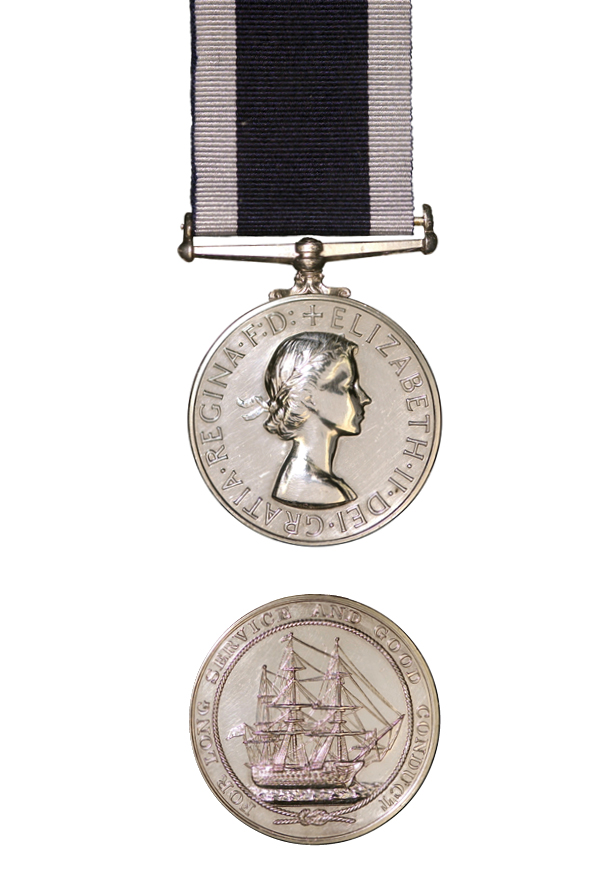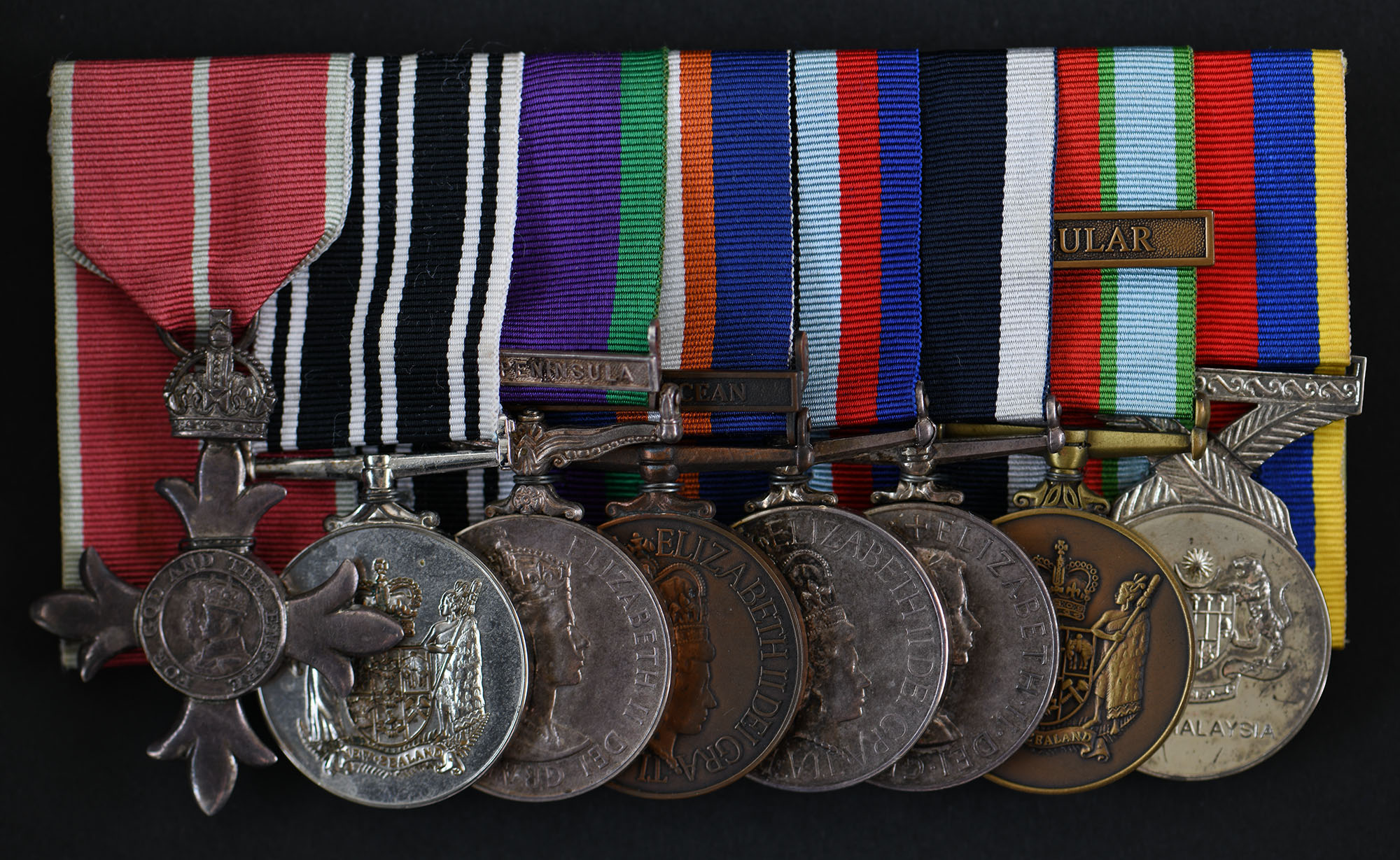

Display No. 19E
MUTCH, Ken Mervyn
Ken Mervyn Mutch enlisted in the Royal New Zealand Navy (RNZN) in 1957 as a Junior Stores Assistant at HMNZS Tamaki. During his long career he served in the Stores’ branch onboard many RNZN ships and shore establishments.
In 1959 Mutch was posted to HMNZS Royalist when the ship was deployed to the Commonwealth Strategic Reserve. As a part of the Strategic Reserve, Royalist undertook operations against Malayan terrorists, including bombardments, and exercised with other Commonwealth ships. For his involvement in this deployment Mutch was awarded the General Service Medal 1962 with Malay Peninsula clasp as well as the Pingat Jasa Malaysia medal. In 1974 Mutch became a Member of the Most Excellent Order of the British Empire (MBE). The following year he was commissioned as an officer, progressing to the rank of Lieutenant Commander in January 1982 when he was posted to HMNZS Waikato. During this time Waikato was part of the Armilla patrol in the Indian Ocean, relieving Royal Navy vessels being deployed to the Falklands War. For this deployment he was awarded the New Zealand General Service Medal 1992 (Non-Warlike) with Indian Ocean clasp.
Whilst serving in HMNZS Waikato, Mutch volunteered to be a liaison officer and was sent to the Seychelle Islands. A local military force staged a mutiny trying to overthrow the government and for five days Mutch was instrumental in helping keep 117 guests alive inside a hotel, despite the staff having fled.
In December 1983 Mutch was posted as Planning Manager to the Naval Supply Depot, HMNZS Philomel, a position he held until he took his discharge in late 1984. He returned to active service in April 1986, serving as Fleet Supply Officer before taking his final discharge in 1991.
Awarded medal(s)
Member of the Most Excellent Order of the British Empire (MBE)

Established by King George V in 1917 for services to the British Empire. The Order has five classes: Knight and Dame Grand Cross (GBE), Knight Commander and Dame Commander (KBE / DBE), Commander (CBE), Officer (OBE) and Member (MBE). The MBE badge is in frosted silver. In December 1918, the Order was split into two divisions: a Civil Division for civilian recipients; and a Military Division for awards to commissioned officers and warrant officers for distinguished service in action. The insignia of the Civil and Military Divisions is distinguished only by the ribbon, the military award having a narrow central stripe. Prior to the introduction of the New Zealand Order of Merit in 1996, the Order of the British Empire was the most common honour awarded to New Zealand military personnel.
The New Zealand Operational Service Medal

The New Zealand Operational Service Medal (NZOSM) was instituted in 2002 to recognise New Zealanders (military and civilians) who have served since the end of the Second World War. The NZOSM provides recognition for those who have earned a campaign medal or completed 7 days or more of operational service since 3 September 1945. It is awarded once only to an individual, regardless of how many times he or she has deployed on operations. The medal features the New Zealand Coat of Arms on the obverse and a kiwi on the reverse. The ribbon is black and white stripes, representative of New Zealand’s national colours.
The General Service Medal 1962

The General Service Medal 1962 was instituted in 1964 (replacing both the Naval General Service Medal 1915-1962 and General Service Medal 1918-1962) to recognise service in minor operations for which no separate medal was intended. This medal was always awarded with a clasp for the specific area of operation. A total of 14 clasps have been issued but only two have been awarded to New Zealanders in significant numbers. These are the ‘Borneo’ and ‘Malaya Peninsula’ clasps awarded for service related to the Indonesian Confrontation of the 1960s.
New Zealand General Service Medal 1992 (Non-Warlike)

The New Zealand General Service Medal 1992 was instituted to recognise service in non-warlike operations for which no separate New Zealand, British Commonwealth, United Nations or NATO campaign medal was issued. Thirteen clasps have been issued for non-warlike (peacekeeping) operations since 1954. In 2002 it was replaced by the New Zealand General Service Medal, 2002. The design and colours of the ribbon are based upon the New Zealand Medal 1845-47 and 1860-66.
New Zealand Armed Forces Award

A long service decoration for Regular Force Officers of the New Zealand Defence Force. Established in 1985, it was originally presented for 15 years of unblemished service. In August 2020 the criteria was modified to be awarded for 14 years service. The medal ribbon colours of dark blue, crimson and light blue represent the three Services (Navy, Army and Air Force) with a black central stripe symbolising New Zealand. The ribbon of the award was designed by Mr Phillip O’Shea, New Zealand Herald of Arms Extraordinary.
The Royal New Zealand Naval Long Service and Good Conduct Medal

The Royal New Zealand Navy Long Service and Good Conduct Medal was instituted in 1985, to replace the Royal Navy Long Service and Good Conduct Medal, with eligibility being backdated to 1 December, 1977. It is awarded to naval ratings up to and including the rank of Warrant Officer who have completed 14 years unblemished service.
New Zealand Defence Service Medal

The New Zealand Defence Service Medal (NZDSM) was instituted in April 2011 to recognise military service since the end of the Second World War. One or more of four clasps can be awarded with the medal determined by military service undertaken: Regular, Territorial, C.M.T. (Compulsory Military Training) and National Service.
Eligibility is three years of service in either the Regular or Territorial (Reserve) Forces of the New Zealand Defence Force (Navy, Army, Airforce), or those who undertook Compulsory Military Training (under the Military Training Act 1949) or National Service (under the National Military Service Act 1962).
The medal itself has the New Zealand fern frond and the badge of the New Zealand Defence Force which combines the emblems of the (Navy, Army and Air Force). The ribbon colours also represent the three services: Navy (dark blue), Army (red) and Air Force (light blue).
Pingat Jasa Malaysia Medal

This Malaysian medal was instituted by the King of Malaysia for award to British Commonwealth personnel who served during the Malayan Emergency and the Confrontation, 1948-60. The ribbon has five vertical stripes in the colours of the Malaysian national flag.

